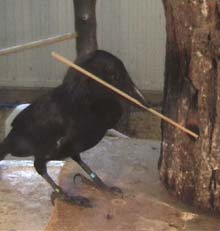Betty The Crow Is Right-Handed

Crow using dowelling to extract mealworms from a hole; holding it with the non-working end against its right cheek Credit: University of Oxford JPG
New Caledonian crows, known to be very proficient tool-users, have a preferred way of holding their tools comparable to the way humans are either right- or left-handed, according to research by Oxford zoologists, recently published in ’Biology Letters’.
Studying the tool use of 10 captive New Caledonian crows, the researchers found that each bird had a consistent preference for holding a piece of dowelling either near its left or its right cheek when trying to retrieve mealworms from a hole in a piece of wood. Five of the birds preferred to use tools left-laterally, and five right but laterality did not obviously differ between male and female crows.
The findings are surprising as it is rare to find animals with such exclusive lateral preferences for manipulative tasks. Only 50 per cent of chimpanzees, for example, are committed to always using the same hand for tool use.
Mr Alex Weir of the Behavioural Ecology Research Group at the Oxford University’s Department of Zoology said: ’Our results show that individuals have very strongly preferred ways to hold tools but there is no apparent population preference. This result is still preliminary, since the sample size is too small to firmly conclude that there is not population-level laterality.
’However these results appear to contrast with other research, which showed that crows have a population-level bias for manufacturing tools, suggesting that the manufacturing and use of tools in this species may have different neural underpinnings.’
Media Contact
More Information:
http://users.ox.ac.uk/~kgroup/tools/laterality.htmlAll latest news from the category: Life Sciences and Chemistry
Articles and reports from the Life Sciences and chemistry area deal with applied and basic research into modern biology, chemistry and human medicine.
Valuable information can be found on a range of life sciences fields including bacteriology, biochemistry, bionics, bioinformatics, biophysics, biotechnology, genetics, geobotany, human biology, marine biology, microbiology, molecular biology, cellular biology, zoology, bioinorganic chemistry, microchemistry and environmental chemistry.
Newest articles

Sea slugs inspire highly stretchable biomedical sensor
USC Viterbi School of Engineering researcher Hangbo Zhao presents findings on highly stretchable and customizable microneedles for application in fields including neuroscience, tissue engineering, and wearable bioelectronics. The revolution in…

Twisting and binding matter waves with photons in a cavity
Precisely measuring the energy states of individual atoms has been a historical challenge for physicists due to atomic recoil. When an atom interacts with a photon, the atom “recoils” in…

Nanotubes, nanoparticles, and antibodies detect tiny amounts of fentanyl
New sensor is six orders of magnitude more sensitive than the next best thing. A research team at Pitt led by Alexander Star, a chemistry professor in the Kenneth P. Dietrich…





















